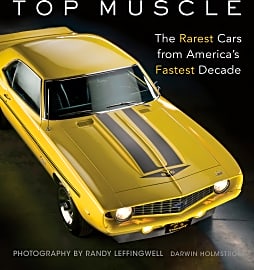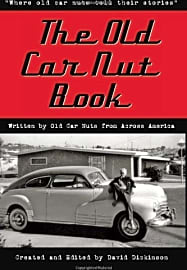The 10 Best Classic Car Books

This wiki has been updated 37 times since it was first published in August of 2015. Whether you call them petrol heads or gearheads, anyone interested in vintage rides would appreciate one of these classic car books. Covering the whole gamut of automobile history and culture, from the first production car through to muscle cars, luxury models, and old workhorses, we've included something to appeal to all those with a fondness for four-wheeled transportation. When users buy our independently chosen editorial recommendations, we may earn commissions to help fund the Wiki.
Editor's Notes
April 30, 2020:
Removed the Classic Car: The Definitive Visual History in favor of the The Art of the Classic Sports Car.
The Art of the Classic Sports Car is an excellent pick for those that are interested in learning about how performance-oriented street cars developed over time, stemming from the first race cars. Each spread includes information about what sort of engines were used, how they were developed, along with improvements in handling technology. Apart from treating each model individually, the author also situates the cars within the greater picture of the car world and explains the impact they had on history.
Even though some Europeans poke fun at the excesses and brashness of American muscle cars, putting the largest engines into the smallest packages produced some of the greatest (and some of the best looking) cars. Top Muscle features great spreads of icons like the classic 69 GTO with the infamous 6.6 litre engine and 4-barrel carb. I have a soft spot for the 65 but really, even the Judge was an awesome car. The stunning photos were produced by Randy Leffingwell who placed the cars in the dark and then flooded them with light for about 30 exposures, which results in beautiful contrasts and highlights.
Choosing a Classic Car Book
And a book is certainly cheaper than a 1939 V12 Rolls Royce Phantom III Luxury Touring Car.
You don't have to know a crankshaft from a camshaft or an alternator from a flywheel in order to appreciate the beauty, ingenuity, and sheer power of many of the world's most celebrated cars. You simply have to accept that cars -- and trucks, SUVs, motorcycles, and so forth -- have played a huge role in recent history and that, to many people, they are much more than a mere tool of conveyance. The car takes on a near-mythical status in the mind of some people, thus the plethora of material dedicated to their appreciation. From museum exhibits to car shows to television programs and so forth, the auto is the frequent subject of celebration, study, and investment, as well. Perhaps no resource is better for studying and admiring the car than a book dedicated to classic automobiles. And a book is certainly cheaper than a 1939 V12 Rolls Royce Phantom III Luxury Touring Car.
When you leaf through a good book devoted to classic automobiles, you don't have to possess prior vehicular knowledge to appreciate the famous and fabulous cars that helped shape the automotive industry throughout the 20th century. Consider selecting an automotive topic that interests you generally -- a type of car, e.g. -- or plan to learn more about an era by studying its vehicles. Indeed the type of car created in any given year says much about the wider culture of the times; as evidence, see the elaborate vehicles of the Art Deco era of the 1920s and 30s or the rugged muscle cars of the the 60s and 70s.
As a generalization, there are two approaches to appreciating the classic automobile. The first is to see the vehicle as a wonderfully designed machine; the second is to view the vehicle as a lovingly designed work of art. Within these two divergent approaches to the topic -- which can be thought of in terms of mechanical and aesthetic for shorthand -- there are still further differentiations of approach. Some car books assume a chronological angle in their study of the auto, considering myriad types of car and examining changes through the decades, while others focus on a particular type of vehicle (the muscle car being a good example) and, often, look at a more distinct period of time -- both the 1930s and 1960s receive particular attention.
Before choosing a classic car book make sure you know whether this book is weighted more heavily on the mechanical, technical, and engineering side, or whether it errs on the side of aesthetics, design, and history. While someone with an appreciation and aptitude for engine design and specifications can often also appreciate artistry of design, there tends to be little cross-over in the other direction, so be sure to choose carefully if you or a gift recipient fall into the latter category.
Also keep in mind that some car books are ideal coffee table tomes, rich with pictures and shorter text sections that make for fine reading even in limited doses, while other books are filled with prose and demand actual cover-to-cover reading. Determining into which category a book falls takes mere minutes, but skipping this assessment may leave you with a book that does little to rev your intellectual engine.
Three True American Classics
The first vehicle recognized as a legitimate "car" was designed by a German in the year 1886. It was in America, however, that the first cars that were in reach of the general public were developed and sold. The motor vehicle would come to define much of American history throughout the 1900s; a few automobiles stand out as emblematic of the wider car culture of the United States.
Its production period lasted from 1908 the 1927, during which time more than fifteen million Model Ts were built -- an impressive record for a car of any era.
The Ford Model T is routinely recognized as the most important and influential vehicle of all time. Its production period lasted from 1908 the 1927, during which time more than fifteen million Model Ts were built -- an impressive record for a car of any era. It was the affordable and reliable Model T that first democratized the car, with many middle class families able to afford the automobile. The vehicle's two-speed transmission allowed for a top speed of just a little more than forty miles per hour, which may seem slow by modern standards, but was swift in its era.
The Mustang, released in the early 1960s, was the first in a new category of vehicles colloquially called the "pony car." It was aggressive and sporty, but also priced in range for the average consumer. Mustangs have been in steady production since their first major production year of 1964, and have gone through many aesthetic updates while remaining at their soul a fast, affordable car.
The world's first minivan was the Dodge Caravan, which was released in 1983 after more than a half decade of development. While not an aesthetic marvel or performance powerhouse, the new vehicle category was nonetheless a runaway success thanks to its pure practicality. Within a handful of years, every major automaker had developed and released its own variation on the minivan, and the vehicles dominated much of the family market for the remainder of the 20th century.
A Brief History of the Automobile
As noted above, the first machine generally recognizes as a classifiable automobile -- a.k.a. simply a car -- was developed in 1886 by German inventor Karl Benz, namesake of one half of the global luxury brand Mercedes-Benz that is still very much extant today. The Benz Patent-Motorwagen used a tricycle wheel arrangement and was powered by an engine producing around two-thirds of a horsepower unit. It drove at a top speed slightly below ten miles per hour.
An 1898 model of the vehicle was updated with metal plating and a forward-facing machine gun.
The first American-made motor vehicle was released in 1893. The Duryea Motor Wagon was built using a converted horse-drawn carriage outfitted with a combustion engine. Its single-cylinder engine produced four horsepower, and has the dubious distinction of being the first vehicle outfitted with armor and a weapon. An 1898 model of the vehicle was updated with metal plating and a forward-facing machine gun.
While assembly line production of cars commenced in an Oldsmobile factory in 1902, Henry Ford pioneers the moving assembly line a decade later, leading to truly efficient mass production of automobiles and lowering the price point of cars to match the budget of millions of consumers.
By the middle of the 20th century, there were approximately 62 million cars owned by Americans, which represented about one car for every three people. By the first decade of the 21st century, that figure had risen to more than 137 million cars owned in the United States, or almost one car for every two Americans.















